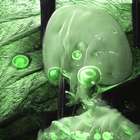Residency softBomb (Rachael Tempest, Lucas Chirnside)
How do we make our realities more malleable, less static? How to we open up physical objects and make apparent their relationships, their connections with other things, events, or people? In Bruce Sterling’s words - how do we move from technological gizmos to spimes (or space-time media)?
During their residency in 2004, Lucas Chirnside and Rachael Tempest prototyped softBomb. Softbomb takes the classical museological trope of the glass display cabinet and reinvents it as a plastic and dynamic virtual interface; all the edges and planes of the case become multimodal “lenses” for examining the many hidden lives of an object. The project aims to apply a “topological media” approach to virtual interfaces that privilege transformation and play. softBomb is also valuable as a tool for research and performance, for analysing and manipulating the contextual, cultural, physical, chemical and historical networks inherent to all objects - splitting the “physics from the physical” and creating a rich platform for mining their hidden life, beyond traditional linear readings of the artefact.
A taxonomy of site-specific artefacts will be modelled into a database of 3D virtual objects. Using a highly malleable haptic interaction device, players will then select and “jam” with their choice of object, “releasing” a dynamic flow of data - the artefact’s inherent meaning systems. This realtime data is simultaneously streamed into the “softBomb,” a custom-built visualisation engine - initially playable within 3D gamespace, but designed as a component for future Mixed Reality environments.
Created: 28 Sep 2011 / Updated: 15 Jul 2021



